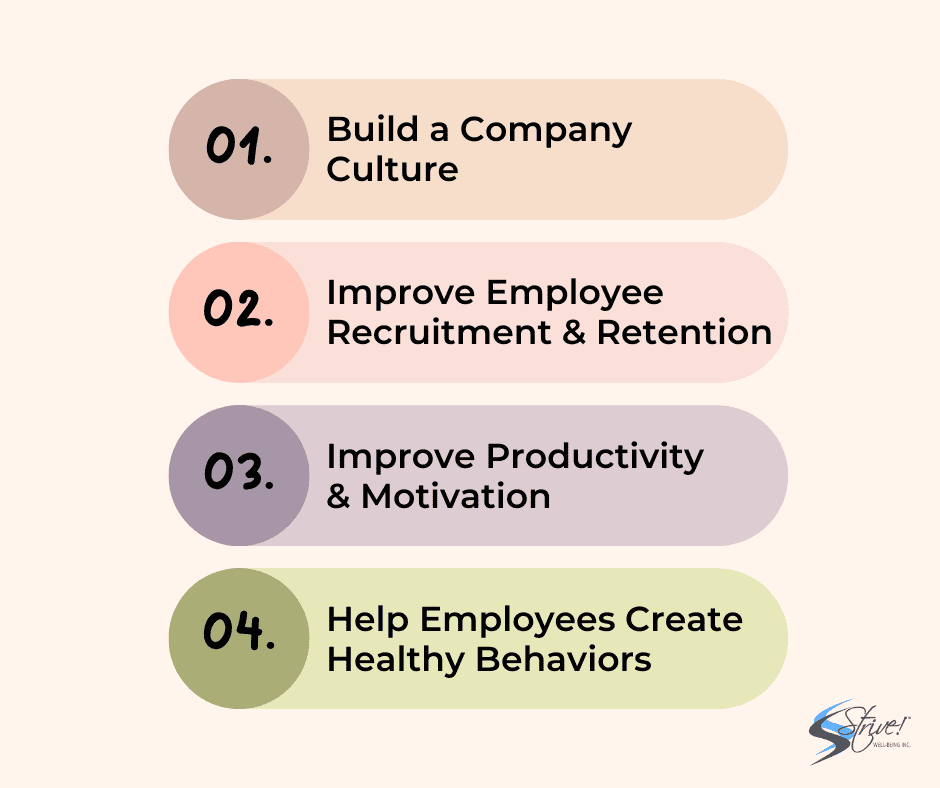How Do Employee Wellness Programs Benefit Employers?
Creating an employer-sponsored wellness program can improve the health and productivity of employees. Business leaders are looking to understand how wellness programs can benefit the company beyond cost-containment. Because of the many options for investing in a company’s human capital, business leaders want to ensure that those channeled resources are the highest value for their investment.
Today we’re discussing four benefits organizations can expect to see when they create meaningful wellness programs for their employees.
Benefits of Wellness Programs for Employers
In this post:
1. The Relationship Between Employer & Employee Has Changed
2. Why Companies Should Have Employer-Sponsored Wellness Programs
a. Build a Company Culture
b. Improve Employee Recruitment & Retention
c. Improve Productivity & Motivation
d. Help Employees Create Healthy Behaviors
The Relationship Between Employer & Employee Has Changed
The Great Resignation has clarified one matter: employees are willing to walk away from job security for opportunities elsewhere. Reasons include seeking competitive wages, advancement opportunities, work-life balance, flexible work hours, and better benefits. This underscores the shifting attitude of employees towards organizations that employ them: a workplace is replaceable in the pursuit of having a certain standard of living.
To punctuate these findings, CNBC reports that 44% of workers are looking for a new job despite inflationary pressures on households. Nearly half of all employees are keeping their options open and ready to make a deal with another company in today’s job market.
In response to the report, companies are evaluating what wellness services to offer as part of their initiative to improve employee well-being. Whether a company is seeking to retain talent, reduce cost-per-hire, or views their employee turnover as a symptom of a deeper problem, having an engaging wellness program can help create compelling reasons for employees to stay with the company for the long haul.
Why Companies Should Have Employer-Sponsored Wellness Programs
Articles written about the hard return on employee wellness programs and over 20 more workplace wellness statistics reinforce the value of wellness in the workplace. These statistics convey the relevance of employee wellness programs and why a consistent focus on employee well-being must be noted. We’ve distilled these findings into four ways an employer-sponsored employee wellness program shows value of investment (VOI) that addresses the changing outlook of employees and the competitive job market:

Employer-Sponsored Wellness Programs Build Company Culture
One of the biggest trends in the job market in 2022 is brand building, marketing the organization to prospective hires by emphasizing mission and culture. A comprehensive wellness program can expand an organization’s total rewards package and build a culture supporting employee well-being efforts.
What makes wellness programs unique as a culture-building asset is how easily wellness programs can tie into an organization’s overall mission.
One of our clients, Blue Shield of California, is a mission-driven organization that incorporates their wellness program into its mission. Their Total Rewards Benefits Guide states,
“Blue Shield of California strongly believes that [their] employees are the driving force that makes [them] the premier health care leader in the market.”
The explicit correlation between their employees and company success sends a clear message to current and future employees. Their total rewards package extends beyond basic benefits to give Blue Shield of California employees access to resources to have a better quality of life, which includes a robust wellness program for onsite and remote workers as part of BSCA’s Wellvolution offerings. Blue Shield of California’s total rewards program offers employees access to wellness resources across eight dimensions:
- Physical
- Social
- Emotional
- Occupational
- Financial
- Spiritual
- Intellectual
- Environmental
Jasmine, Wellness Program Manager at BSCA, shared with us that their daily mission is to make BSCA, “a great place where people can do great work.” It’s evident from talking with Jasmine and reading Blue Shield of California’s total rewards guide that the organization believes supporting their employees’ well-being leads to great work, and the employees think so, too. Employee reviews on Glassdoor from employees across the organization show that they believe BSCA is an employee-focused employer.
What’s important to remember is that BSCA’s total rewards package is an expression of their culture and mission. Employees still need to engage with the benefits to experience the intention of a mission-driven organization. The wellness program is a tangible way for BSCA employees to become immersed in BSCA’s core values and mission.
Employer-Sponsored Wellness Programs Improve Employee Recruitment & Retention
With websites like Glassdoor, it is easier than ever for job-seekers to navigate and review potential employers. Employees are willing to walk away from their current jobs for better pay, room for advancement, work-life balance, flexible work hours, and better benefits even as we enter an economic downturn.
Even if the United States was in an economic boom, is the only way to compete for talent to spend more on paychecks and benefits?
The American Psychological Association found fewer employees said they intended to leave their job in the next year (25% vs. 51%) when receiving senior-level support. This includes any involvement and commitment to well-being initiatives. The report also showed that 9 out of 10 of those who supported employees were likely to recommend their company as a good place to work.
This goes beyond having competitive benefits and pay structure, and suggests that a company with a well-being focused culture influences employees to stay and recommend the company. The real challenge then, is getting employees to envision themselves with the organization five, ten, or twenty years into their future. Long-term organizational commitment goes beyond having a competitive benefits package. It means creating a great place to do great work where employees have the space to meet their wellness needs.
Employer-Sponsored Wellness Programs Improve Employee Productivity & Motivation
Organizations that make their wellness culture an experience also see improvements in productivity. The American Psychology Association reported that 9 out of 10 employees felt motivated to do their best when senior leaders supported well-being initiatives. When senior leaders involve themselves with the organization’s wellness program, employees feel encouraged to improve their personal well-being and do their best. Employee action mirrors leadership action.
This ties back to culture-building, as wellness programs are a firsthand example of an organization investing in its employee population. In effect, companies that champion wellness can also say that the organization helps employees achieve excellence. That is different from companies that value excellence but do not showcase how excellence is achieved within their organization. This distinction highlights how leadership-supported wellness programs motivate employees and improve productivity.
Wellness programs also improve productivity by addressing absenteeism and presenteeism.
Absenteeism is the unplanned absence from work. Some reasons for absenteeism include illness, family-related issues, workplace harassment, and job hunting. On the other hand, presenteeism refers to lost productivity from employees performing suboptimally on the job for illness, injury, or other conditions that negatively affect focus.
An article from SHRM reported that business leaders already see a direct correlation between wellness and productivity. These leaders are taking a broader view of their wellness programs beyond cost-containment instead of lowering any current or future health insurance claims by improving today’s physical health. These organizations are creating wellness programs that offer employees resources to help them achieve wellness across the eight pillars of wellness. When employees are whole, they apply their whole attention to their tasks.
If we take the reasons for productivity-loss and categorize them under the eight pillars of wellness, we can begin to see how a wellness program that attends to multiple pillars of wellness helps mitigate absenteeism and presenteeism in the workplace.
A weekly yoga class can positively impact an employee’s physical, social, emotional, and even occupational well-being by serving as an opportunity to incorporate dynamic movement into their day, experience connection with coworkers, and help recenter themselves in the middle of work.
Though workplace yoga classes can support multiple pillars of wellness, we still encourage organizations to consider a holistic approach to building a wellness program, because this approach to programming attracts more employees and helps employees address a wider range of needs.
Employer-Sponsored Wellness Programs Help Employees Create Healthy Behaviors
The goal of all wellness programs is to help every employee foster lasting positive health behaviors. This study showed improved health behaviors persisting over two years for employees with a worksite wellness program. Behavioral improvements included exercise frequency, servings of fruit and vegetables consumed, hours of sleep, as well as self-reported mental health outcomes. Once employees take advantage of a good wellness program, they are more likely to adopt and maintain healthy behaviors in the future.
That’s important when gaining momentum for culture-building and employee productivity. Receiving coworker well-being support can be a driving force when influencing workforce culture. Employers will want employees to promote a culture of well-being to reap the previously mentioned productivity benefits.
Discover the top 5 corporate wellness companies in San Diego.



